View current page
...more recent posts
I'm pleased to announce I'll be having a solo show in May at artMovingProjects, in Williamsburg (Brooklyn), NY. Mike Ballou, whose work I've liked since seeing his show of mutated toys on corrugated cardboard ledges at Postmasters a while back, is slated for the Project space. [Update: the Project space assignment is being reshuffled.]
And as if enough personal horn-tooting doesn't go on around here, here's a scan of the Fort Worth Star-Telegram review of my Dallas show with Saskia Jorda, ending this week (yes, I already posted the article, but this is the all-important print edition). As they say, "the best museums in Dallas are in Fort Worth" (the Kimball, etc) and it seems the most conscientious writing on Dallas also comes from there.
Just want the record to reflect that I bought and read the graphic novel V for Vendetta--about a terrorist blowing up buildings in a near-futuristic but Thatcher-like England--a couple of years ago, was impressed and creeped out by it, and have been dreading the movie adaptation since the Alan Moore adaptations to date have been bad. James Wolcott gives the Wachowskis' V for V a solid advance plug.
Am reading Emmanuel Carrere's Philip K. Dick bio I Am Alive and You Are Dead, discussed earlier here (including a retort from Gary Indiana, whose review of the book was being bashed). Carrere's narrative is definitely a delight for a Dick cultist: I love the way he recounts one of Dick's daydreams--an astronaut reading aloud from a satellite to radio listeners as he circles endlessly over a post-nuclear holocaust Earth--without tipping off non-insiders that that's one of the subplots of Dr Bloodmoney, or the interweaving of Dick's day to day bloody marital battles into a plot synopsis of Clans of the Alphane Moon. It's oodles of fun if you already know everything about Dick (and most of the particulars of Carrere's tale have been told elsewhere). The down side of Carrere's (artful, accurate) blurring of the boundaries between Dick's life and fiction, though, is that it gives ample material for haters like Indiana. If you don't like PKD's writing, the author is just a bundle of neuroses and the writing merely a symptom of those neuroses.
For some of us, though, Dick was how we survived the Reagan '80s. Powerless to stop the eight year reign of the stupid, overhyped Gipper, it was easy to retreat into Dick's "fictional" world--not so easy to create, not as dismissable as Indiana would have you believe--and know that was an animatronic dummy, possibly an insect creature from space, up there on the TV mouthing platitudes scripted by sharp ad men. Indiana, meanwhile, spent the decade limning the Boom's art world sociology, in the pages of the Village Voice: Just another kind of useless metafiction, but with a high culture connection Dick never had.
A while back I was talking about the art and theory connections in former Art & Language artist Kathryn Bigelow's "failed summer blockbuster" K-19: The Widowmaker. The heart of the film, which some '02 reviewers found "extremely claustrophobic and unpleasant," is a scene where Russian submariners wearing only chemical suits (because the military forgot to provide them radiation suits--"They might as well be wearing raincoats," says one character) enter the reactor room in 10 minute shifts to perform a complicated welding operation. Each set of crews emerges half-dead, vomiting, their skin looking like raw hamburger. Worse, the next set of crews sees them and knows that's what they're going to look like in ten minutes.
The style is as bleak as the industrial safety film genre, bleaker, because even those films have a kind of unintentional slapstick with limbs severed by forklifts, spurting blood a la Monty Python, etc. K-19's reactor scene is pure unrelieved horror. Hard not to think of the 9/11 rescue crews going into the cauldron of burning toxic materials to pull out fragments of bodies. And as with the K-19 crew, poorly supplied and poorly informed by an inept government, the 9/11 crews are now dying from those toxic hazards. When I saw K-19 in 2002 I couldn't believe how brutally honest Bigelow was being in a summer blockbuster. She was taking us all into the dirty secret world of modernity, the "down side" of technology that we live with every day and simply can't bear to think about. Here's a Wikipedia entry on Paul Virilio's theories of the "integral accident" (previously posted with a GIF of a mutated monster truck):
Technology cannot exist without the potential for accidents. For example, the invention of the locomotive also entailed the invention of the rail disaster. Virilio sees the Accident as a rather negative growth of social positivism and scientific progress. The growth of technology, namely television, separates us directly from the events of real space and real time. We lose wisdom, lose sight of our immediate horizon and resort to the indirect horizon of our dissimulated environment. From this angle, the Accident can be mentally pictured as a sort of "fractal meteorite" whose impact is prepared in the propitious darkness, a landscape of events concealing future collisions. Even Aristotle claimed that "there is no science of the accident," but Virilio disagrees, pointing to the growing credibility of simulators designed to escape the accident--an industry born from the unholy marriage of post-WW2 science and the military-industrial complex. A good example of Virilio's integral accident is Hurricane Katrina and the disastrous events that followed, which brought the eyes of the world upon a single nexus of time and place.The bloody mess in Iraq is also a denied side of the West's modernity. The US caused it, the US pretends it isn't happening while continuing along the crazed path of ultimate consumption and non-stop electronic amusements. Not trying to be a Cassandra here, and I'm not opposed to electronic amusements, just wondering if it's possible to have them without living with endless untenable contradiction.

VISUAL ACID
March 3 - March 25 2006
Secret Project Robot, Brooklyn New York
Secret Project Robot and Harkness Audiovisual present VISUAL ACID, a collaborative installation by Nick Hallett, Leif Krinkle, Zach Layton, and Brock Monroe, which takes as its starting point the electronic disco genre, Acid House, to construct an immersive environment of rhythmic light.
Defined by the sounds of the "808" drum machine and "303" bassline sequencer (both developed by Japanese electronic music manufacturer Roland) Acid House music was created by Chicago-based DJs during the mid-1980s.
VISUAL ACID will too be defined on the basis of these revolutionary music computers. The centerpiece of the installation is a genuine 808, its basic functions harnessed to trigger a series of stroboscopic, fluorescent light fixtures through the unit's individual audio outputs (a remarkable and unique feature of the 808), thereby reimagining the instrument as a fully interactive visuals-generating tool. As its companion, an "Optical 303" squelches the imaged representations of signature Acid basslines, which are projected through rotating prisms and shot throughout the space as cinematic, rainbow-infused light.
An opening reception will be held at Secret Project Robot on Friday, March 3 from 7 to 9 pm.
To coincide with the exhibition of VISUAL ACID, a variety of related events held will be hosted at Secret Project Robot, culminating in a "Bubblifique" extravaganza on March 25. As the space does not hold regular hours, these events will be the only times VISUAL ACID is open to the public. Please visit www.harknessav.org for more information.
Secret Project Robot is located at Monster Island, 210 Kent Avenue at the corner of Metropolitan Avenue in Williamsburg, Brooklyn. Entrance to the gallery space is on River Street. For more details, contact Nick Hallett, nick(at)harknessav(dot)org.
UPCOMING HARKNESS EVENTS
March 9 at 10:30 PM
HOW THE WEST MAY SAVE US YET: music vidz from the underground resistance
New York Underground Film Festival screening curated by Nick Hallett.
All-Out Civil War in Iraq: Could It Be a Good Thing? (Asks Fox News)
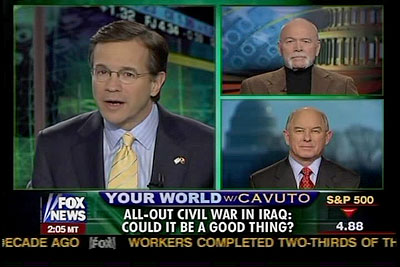
From the Cheney Administration's (corporate) Goebbels. Just posting this for posterity. David Asman, the twit with the yellow tie, is the classic dweeb who couldn't get a girlfriend in high school and had to join the chess club and still burns with resentment. Bush, a spoiled but powerful bully, is the perfect person for him to support.
Just realized the fifth anniversary of this weblog was two days ago. *cheers, fireworks, etc* Here was my first post; feels like I wrote it yesterday. The site design hasn't changed in all this time so nothing looks any different (except the initial capitals in my logon). As always, thanks to Jim Bassett for the excellent software that continues to run glitch- and spam-free, and to the Digital Media Tree community of bloggers who are keeping the spirit of '99 alive while blogging has run through several hype cycles.
Was just reading a (non-Tree) blogger's lament that his page didn't rate an Armory Show press pass. (The Armory is the big art fair that New York galleries have for people so decrepit they can't see art if it requires walking more than a block. You know, bladders and colostomy bags fill up and there's only so much you can do in a day.) That blogger's bellyachin' is a sign, I suppose, that the medium is maturing--that people are even talking about that kind of stuff. The story had a happy ending--his online moaning embarrassed the Armory gatekeepers into issuing the all important pass.
Some new work by Joe McKay:
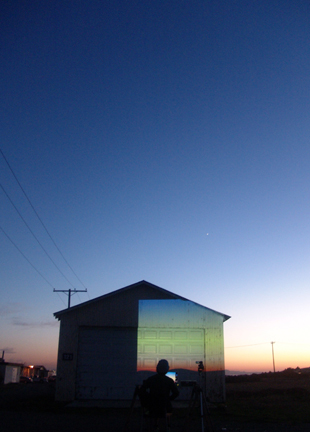
Sunset Solitaire. Artist projects Flash color bands against building silhouetted in front of actual sunset, tries to match the colors, a la a veejay mixer. Human vs. Nature, who will win this video game? (See also McKay's Color Game.)
Kinetic Computer Sculptures. In these pieces, the private inner guts of computer hardware are opened up to mock-surveillance, like proctoscopy, except instead of what you sit on it's what you sit and use all day. An opened, violated Mac tower has a small robot searchlight sweeping its innards, while on an adjacent monitor, footage is shown of the same scene that doesn't match (like the video loop of Keanu and Bullock that fools Dennis Hopper in Speed).
In another piece, an ink jet printer is rigged for auto-voyeurism, watching its own print head as it slides lasciviously back and forth. Except, again, the footage is fake.
Chris Ashley has a good article on McKay here.
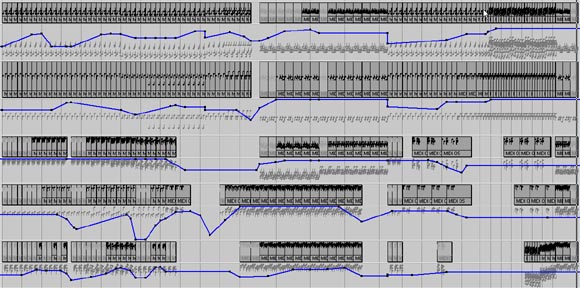
"Composition for Stringed Instruments" [5.5 MB .mp3].
This is the final, four minute version, barring minor tweaks; the previous posts are just parts of this. I'd like to give big props to musicians Sue Lynn, Art, Dmitri, and Enid for putting up with all the retakes while we recorded the string parts. You did especially well imitating the slight pauses and minute imperfections of the sampler and sequencer--that was really perverse of me to ask you to do that. You will get your checks soon! All my love to the music scene--keepin' the spirit "downtown."
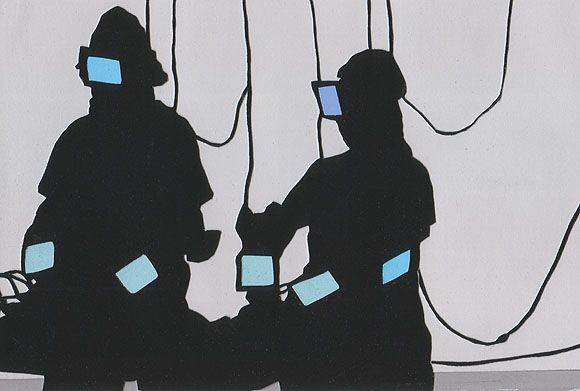
Brian Alfred made this image of the art/sound/performance duo LoVid; it's an analog remix of my digital camera photo. The materials are collaged, cut Color Aid paper and the dimensions are 9 by 12 inches. Alfred has a show of paintings opening March 4 at Mary Boone Gallery, and an animation piece upcoming in March in Times Square. Curious to see both--I've only seen the paintings in reproduction, but he is a great animator and a whiz with the X-acto knife.
"String Quartet Piece" (second posting of work in progress with additional music) [mp3 removed].
Final version here.
Internet (sort of, this 18.8 MB .mp4 is more documentation, a kind of moving thumbnail, of a DVD, than "web art" per se):
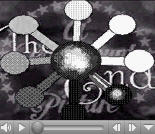
Non-Internet (screen shots of the DVD on a TV):
 |
 |
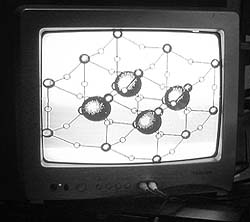 |
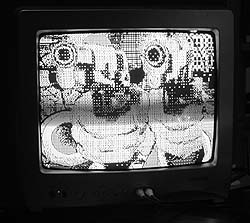 |
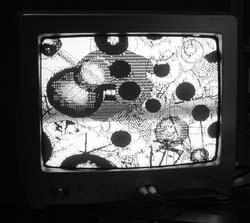 |
 |
 |
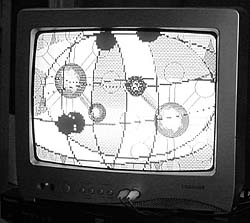 |
Dear Music Diary, I've already reached the point in this string quartet piece I'm writing where I wanted to transition out of the lugubrious intro and into something peppier. I blocked in this sort of Euro-country dance thing but it wasn't working in 4/4 time and it was way too slow. I counted the beats to make it work--could something possibly be in 23/8 time? 23 is a prime #, I'm already feeling the math in this piece. (Googled and sure enough Genesis worked in 23/8, for the "chase sequence" in "Robbery, Assault & Battery"--Tony Banks called the rhythm "insane.") So I went with it, added another bar with 23 beats where the pizzicato strings come in, gradually increased the tempo from 120 bpm to 200, and used a slow volume fade to diminish the bass and cello parts still grinding away in 4/4. Now I'm ready to embellish on that "dance."
Final version here.
No, the blogosphere won't change the global economy...with sycophants like this asking the questions.
Remember the video that went around in '04 showing how to open a Kryptonite lock with a bic pen? According to business blogger Dave Taylor, it didn't hurt Kryptonite at all. How does he know? He interviewed the public relations manager at Kryptonite.
Q: How long did it take for your company to be aware that there was negative publicity in the blog community?Hope you caught that last part: The p.r. person can't definitively say Kryptonite isn't suing the individual who posted on an online bike forum about the lock--a product the company ultimately replaced as deficient, in numbers up in the hundreds of thousands. That's a great way to restore confidence in the brand, leaving the impression that truth can be clouded with litigation and that the truthteller will be punished by an entity with better resources.
We were aware of the Internet involvement with this issue from the first day. This included blogs and forums.
[The common "myth" of the Kryptonite story is that the company wasn't paying attention to the blogosphere and that it took weeks for it to learn that there was a problem, but as you can see it isn't true and Donna and her team were aware of the problem from the very first day. --DT]
Q: When you did learn about the negative publicity, did you see it as a crisis management problem, or did it not seem that dire?
Dave, we were working around the clock to research the allegation and create a plan for our customers. We took this very seriously from day one. Contrary to popular belief, the media attention didn't make us take notice of this situation; we were already well into creating a plan by the time the traditional media were publishing their stories. I've seen in print that only after the New York Times article on day five did we come out with a plan and talk to the media. That's not true. We were talking to the media from day one.
[Again, the "myth" of the Kryptonite story, that the company was out of touch and didn't know anything had happened until the New York Times broke the story is completely false. Indeed, it is the desire to debunk the untruths and myths about this entire situation that motivated me to produce this interview with Donna in the first place. --DT]
Q: Did your company ever consider legal action against the person who disseminated the information about how to defeat that particular type of lock?
Need to go corporate here. We don't discuss any legal matters publicly, be they in process or in theory.
"String Quartet Piece 1" [mp3 removed]. Haven't decided if this is a first movement that stops and then turns into something else, or if this basic structure will continue, with other themes gradually woven in. A bit of a departure from the electro and "new/old digital sounds" side of things I've been pursuing. More of a swerve than a change of direction--it's all made the same way.
Final version here.
Video trolling
Home movie clips of babies throwing up set to the 1812 Overture. Some serious projectile hurling here. From the mainstream media.
Japanese kids spazzing out to hardcore beats. Incomprehensible, strangely liberating mashup from a German (?) novelty (?) site (?).
"Look Around You," a BBC spoof of educational/science programming, investigates...music. I love the kids on the quiz show.
(hat tips to singe and mbs)
Bonus online animation from Michael Bell-Smith: "The Gates." You know, that piece by the couple who bamboozled the city last year.
"Cyphering" [mp3 removed]. Bears passing resembling to a monster hit by a certain German proto-techno foursome, so I called mine "Cyphering," which is Jethro Bodine's word for arithmetic. None of my music has vocals, even robots reciting cyphers--don't know why, maybe vocals are too concrete. I am working on a string quartet piece (no, really) and hope to have something up in the next few days.
"Counterdemo" [mp3 removed].
Factory drum demo with MIDI interpreted as both rhythm and melody.
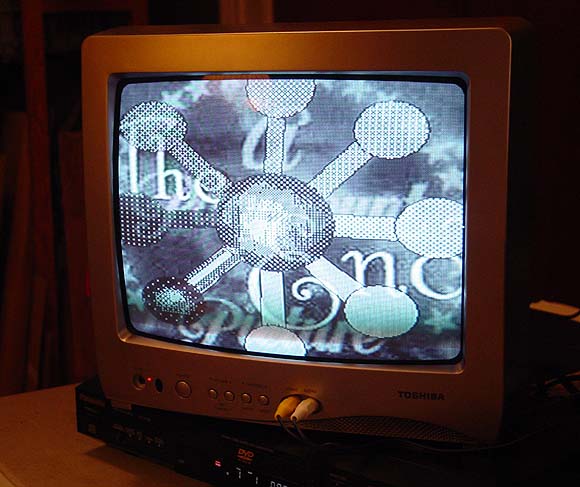
"End Notes" [18.8 MB .mp4]
The .mov file above [converted to .mp4] is one version of this piece. It is a video using (i) my own music and animation and (ii) the collaborative animated GIFs I did with jimpunk in 2004 (including the opening GIF seen above in freeze frame).
I more or less composed the video for the the 13 inch screen above. The music was mixed to monaural and plays on the TV speaker or through headphones. It also looks pretty good in "full screen" mode on the computer, but I was trying to work for the worst case scenario of a cheap TV that cropped a good bit of the border. The TV version is grittier and more aggressive than the .mov file.
Below: Daisy Rock Girl Guitars, from the 2006 NAMM show (the big musical instrument trade show). Other pics, mostly of big wire-festooned analog synthesizers and the dudes who love them, are here. I wondered what NAMM stood for, so I looked it up on their website and here's what I learned:
What does NAMM stand for? NAMM stands for the global music products industry. NAMM stands for you.(The FAQ page says "National Association of Music Merchants.")

Cheney shooting an old man in the heart seems to have given the late-night yukmeisters carte blanche to joke about everything--the war, domestic spying, Administration incompetence. Where was this all this hilarity when we needed it most, that is, before the 2004 election?
Late-Night Jokes About Dick Cheney's Shooting Accident
"Happy Valentine's Day. Good news, good news today -- so far Dick Cheney has not shot anybody." --David Letterman
"Everybody is in the Valentine's mood. For example, earlier today Dick Cheney shot his buddy in the ass with an arrow." --David Letterman
"The real question now is, is this a one-time thing, or will the vice president try to kill again." --David Letterman
"If this story gets any bigger, pretty soon they're going to have to tell the president." --David Letterman
"You can't blame [Cheney]. Bush says you can spy on people without warrants, you can torture people, you can hold people without a trial, so Dick Cheney thinks, 'Oh what the hell, I can shoot a few guys.'" --Jay Leno
"I'm surprised Dick Cheney loves to hunt so much.
The five times the government tried to give him a gun, he got a deferment." --Jay Leno
"What a nightmare I had last night. I dreamed I was at a Washington party and I had to choose between Dick Cheney taking me on a hunting trip or Ted Kennedy driving me home." --Jay Leno
"The rumor is that Cheney may have been drinking and he wanted to wait until he sobered up. So he may have been drinking and then he shot a guy. And you know what's really scary about all of this -- what if it turns out all this time Bush was the smart one?" --Jay Leno
"The guy Cheney shot is a Texas lawyer. While he was lying there on the ground he actually handed himself his own business card." --Jay Leno
"After Whittington had a heart attack, Cheney said, "You big baby. I get those all the time. Walk it off." --Jay Leno
"Mr. Whittington is doing fine, but based on this development, we're going to downgrade the condition of this story from 'Incredibly Hilarious' to 'Still funny, but, mmm, now a little sad.'" --Jon Stewart, on the heart attack Harry Whittington suffered (Watch video clip)
"It turns out now that Dick Cheney did not have a license to hunt, and coincidentally, turns out we didn't have a license to go into Iraq." --David Letterman
"Kind of a sad study out today that single women over the age of 35 are more likely to be shot by the vice president than to find a husband." --Jimmy Kimmel
"Remember when the most embarrassing thing to happen to a vice-president was misspelling the word potato?" --Jimmy Kimmel
"Police are still investigating. They want to know why Cheney was unable to see the hunter at the time of the accident. And, they also want to know how Cheney wound up with his wallet." --Jimmy Kimmel
"The administration has been getting a lot of criticism for how they handled the situation. First, they didn't tell the media for almost a full day after it happed. The White House press corps was furious. They expect to be told when the vice president shoots a 78-year-old man in the face." --Jimmy Kimmel
"Good news, ladies and gentlemen, we have finally located weapons of mass destruction: It's Dick Cheney." --David Letterman
"But here is the sad part -- before the trip Donald Rumsfeld had denied the guy's request for body armor." --David Letterman
"We can't get bin Laden, but we nailed a 78-year-old attorney." --David Letterman
"The guy who got gunned down, he is a Republican lawyer and a big Republican donor and fortunately the buck shot was deflected by wads of laundered cash. So he's fine. He took a little in the wallet." --David Letterman
"Vice President Dick Cheney accidentally shot a man during a quail hunt ... making 78-year-old Harry Whittington the first person shot by a sitting veep since Alexander Hamilton. Hamilton, of course, (was) shot in a duel with Aaron Burr over issues of honor, integrity and political maneuvering. Whittington? Mistaken for a bird." --Jon Stewart (Watch video clip)
"Now, this story certainly has its humorous aspects. ... But it also raises a serious issue, one which I feel very strongly about. ... moms, dads, if you're watching right now, I can't emphasize this enough: Do not let your kids go on hunting trips with the vice president. I don't care what kind of lucrative contracts they're trying to land, or energy regulations they're trying to get lifted - it's just not worth it." --Jon Stewart
"The Vice President is standing by his decision to shoot Harry Whittington. Now, according to the best intelligence available, there were quail hidden in the brush. Everyone believed at the time there were quail in the brush. And while the quail turned out to be a 78- year-old man, even knowing that today, Mr. Cheney insists he still would have shot Mr. Whittington in the face. He believes the world is a better place for his spreading buckshot throughout the entire region of Mr. Wittington's face." --"Daily Show" correspondent Rob Corddry
"Dick Cheney accidentally shot a fellow hunter, a 78-year-old lawyer. In fact, when people found out he shot a lawyer, his popularity is now at 92 percent." --Jay Leno
"Cheney's defense is that he was aiming at a quail when he shot the guy. Which means that Cheney now has the worst aim of anyone in the White House since Bill Clinton." --Jay Leno
"I think Cheney is starting to lose it. After he shot the guy he screamed, 'Anyone else want to call domestic wiretapping illegal?'" --Jay Leno
"When the ambulance got there, out of force of habit they put Cheney on the stretcher. No, the other guy!" --Jay Leno
"Dick Cheney is capitalizing on this for Valentine's Day. It's the new Dick Cheney cologne. It's called Duck!" --Jay Leno
"You know what they say, if Dick Cheney comes out of his hole and shoots an old man in the face, six more weeks of winter." --Jimmy Kimmel
"The Vice President says that it was an accident.
He claims the guy got in his line of fire, but the good news was he was delicious. Eat what you shoot!" --Jimmy Kimmel
"The man who was shot is named Harry Whittington. He's a high powered Republican lawyer, he was very lucky. They say the only reason that he wasn't killed is he was wearing the body armor that never got shipped to our troops." --Jimmy Kimmel
"This is a great story. You've got the Vice President, a shotgun, a bunch of rich guys hunting tiny little birds. The only thing that could possibly make this story better is if he shot Michael Jackson." --Jimmy Kimmel
"But all kidding aside, and in fairness to Dick Cheney, every five years he has to shed innocent blood or he violates his deal with the devil." --Jimmy Kimmel
"So in summary, the Vice President of the United States shot a 78-year-old man in the face. Congratulations Mister Vice President, you are now a Crip." --Jimmy Kimmel
"He is a lawyer and he got shot in the face. But he's a lawyer, he can use his other face. He'll be all right." --Craig Ferguson
"You can understand why this lawyer fellow let his guard down, because if you're out hunting with a politician, you think, 'If I'm going to get it, it's going to be in the back.'" --Craig Ferguson
"The big scandal apparently is that they didn't release the news for 18 hours. I don't think that's a scandal at all. I'm quite pleased about that. Finally there's a secret the vice president's office can keep." --Craig Ferguson
"Apparently the reason they didn't release the information right away is they said we had to get the facts right. That's never stopped them in the past." --Craig Ferguson
compiled here (hat tip shm)

|

|

|

|

|

|

|

|

|

|

|

|

|

|

|
An earlier post on Jerry Saltz's review of Walid Raad has been beefed up to actually make the point I thought I was making.
Permanent U.S. Military Bases in Iraq
Tom Engelhardt on the permanent military bases our taxes are paying for in Iraq, a country we're supposedly "withdrawing" from (forget that):
Thomas Ricks of the Washington Post paid a visit to Balad Air Base, the largest American base in the country, 68 kilometers north of Baghdad and "smack in the middle of the most hostile part of Iraq." In a piece entitled "Biggest Base in Iraq Has Small-Town Feel," Ricks paints a striking portrait:Bush lies, New Orleans dies, Halliburton thrives.
The base is sizeable enough to have its own "neighborhoods" including "KBR-land" (in honor of the Halliburton subsidiary that has done most of the base-construction work in Iraq); "CJSOTF" ("home to a special operations unit," the Combined Joint Special Operations Task Force, surrounded by "especially high walls," and so secretive that even the base Army public affairs chief has never been inside); and a junkyard for bombed out Army Humvees. There is as well a Subway, a Pizza Hut, a Popeye's, "an ersatz Starbucks," a 24-hour Burger King, two post exchanges where TVs, iPods, and the like can be purchased, four mess halls, a hospital, a strictly enforced on-base speed limit of 10 MPH, a huge airstrip, 250 aircraft (helicopters and predator drones included), air-traffic pile-ups of a sort you would see over Chicago's O'Hare airport, and "a miniature golf course, which mimics a battlefield with its baby sandbags, little Jersey barriers, strands of concertina wire and, down at the end of the course, what appears to be a tiny detainee cage."
Ricks reports that the 20,000 troops stationed at Balad live in "air-conditioned containers" which will, in the future -- and yes, for those building these bases, there still is a future -- be wired "to bring the troops Internet, cable television and overseas telephone access." He points out as well that, of the troops at Balad, "only several hundred have jobs that take them off base. Most Americans posted here never interact with an Iraqi."
Recently, Oliver Poole, a British reporter, visited another of the American "super-bases," the still-under-construction al-Asad Airbase (Football and pizza point to US staying for long haul). He observes, of "the biggest Marine camp in western Anbar province," that "this stretch of desert increasingly resembles a slice of US suburbia." In addition to the requisite Subway and pizza outlets, there is a football field, a Hertz rent-a-car office, a swimming pool, and a movie theater showing the latest flicks. Al-Asad is so large -- such bases may cover 15-20 square miles -- that it has two bus routes and, if not traffic lights, at least red stop signs at all intersections.
There are at least four such "super-bases" in Iraq, none of which have anything to do with "withdrawal" from that country. Quite the contrary, these bases are being constructed as little American islands of eternal order in an anarchic sea. Whatever top administration officials and military commanders say -- and they always deny that we seek "permanent" bases in Iraq -– facts-on-the-ground speak with another voice entirely. These bases practically scream "permanency."
Unfortunately, there's a problem here. American reporters adhere to a simple rule: The words "permanent," "bases," and "Iraq" should never be placed in the same sentence, not even in the same paragraph; in fact, not even in the same news report.
Here's what happens if you take the money paragraph from Jerry Saltz's current review of Walid Raad's Kitchen show and present it in the format of Donald Judd's devastatingly terse 1960s reviews, which Chris Ashley has been quoting on his page. The equivocating phrase "--which is fine" at the end of the second sentence is snipped but this is otherwise verbatim from Saltz's generally fairly complimentary seven paragraphs on the artist.
Jerry SaltzJust fantasizing about the old days when reviewers said what they thought without burying it deep within the obligatory summary of the party line.
"In the Galleries"
Village Voice, February 2006
Walid Raad/The Atlas Group: As poignant as several of these pieces are, I'm not really sure Raad is an artist. He's more of a social scientist using art or examining power. He mixes Joseph Beuys, Marcel Broodthaers, and David Wilson's Museum of Jurassic Technology, but there's not a lot of alchemical energy to what he does. His work is smart, doctrinaire, and poetic, but formally it's very nth generation conceptualism. You wonder if all this fictionalized fact, factualized fiction, and secret-intrigue business is even necessary. Sometimes it feels wooden and hokey. His melodramatic Bas Jan Ader–like titles and his talk about "authority" and "authorship" suggest Raad is suave but has a latent pedantic streak. Also, nearly every work here dates from between 1996 and 2000 and has been seen in international exhibitions. He needs to do some new work. (The Kitchen, through March 11)

I like the gallery Foxy Production but it bugs me that they're giving the members of the collective Paper Rad solo shows. It's like saying "Collectives are cool! OK, now let's get back to the valorization of individual geniuses which is what we know and can sell."
The Paper Rad installation at Pace was amazing. They really rose to the occasion. It's better and stronger than anything we've seen from them individually. Their triangular box installation was minimal but the exterior "painted mural" image with Bart Simpson, and the wall-to-wall video projected on the inside of the box were maximal--it was a perfect balance, very thought out.
Jacob Ciocci's recent solo was good, but on the whole I'm more interested in his (and Paper Rad's) video than the physical work. The video *is* radical, but the objects strike me as standard outsider moves (dolls, thrift store items, accumulations of more detail than the eye can take in...)
Which is not to say I didn't find a lot of compelling things to look at in Ciocci's show. I guess the problem is you want so-called cutting edge work to show you things you haven't seen. The "boy's bedroom" with chock-a-block tchotchkes on the walls we've seen. It's a more psychedelic version of a piece like Ed Kienholz's The Beanery--a claustrophobic enclosed room full of "stuff." The video in Ciocci's bedroom was great; I wanted to move all the stuff out of the way so I could see it.
The video murals in the Pace show were something new. Imagine a giant Rauschenberg or Polke painting with all the layered elements *moving*, each independently of the other. The subject isn't some rarified art substance but the worst and silliest pop culture trash--cheesy animated GIFs downloaded off the internet merging and morphing with abstract Flash patterns and found photographs in a constantly changing allover field: dozens of moving and overlapping Hannah Hoch style collages bubbling in and outside your field of vision. Similar things are going on in Ciocci's physical work, but there's something about forcing it onto a rectangular, pixeled 2-D field that tightens it up, makes the familiar strategies seem unfamiliar. With the objects you are weighted down with all the history of those objects.
Also, it's possible that this collective actually works better...as a collective.
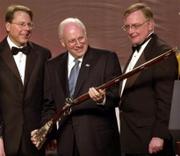

As long as everyone's talking about crack shot Dick Cheney, might as well pile on. From Josh Marshall:
What stuck out to me though is that the owner of the property on which the incident occurred was the person interviewed by the AP. And the property owner, Katharine Armstrong, gave a highly exculpatory recounting of what transpired. Basically, she said the victim, Harry Whittington, snuck up on Cheney, didn't give the appropriate warning. And in any case getting sprayed with shot in the face and half your body isn't that big a deal anyway.They also waited 24 hours to report this, while they worked out a story that didn't make Cheney sound like a complete incompetent moron. I like Armstrong's quote in the New York Times about the physically robust Veep:
But by way of Brad Blog we find that Armstrong is the daughter of the one of the folks who hired Cheney at Halliburton.
''Fortunately, the vice president has got a lot of medical people around him and so they were right there and probably more cautious than we would have been,'' she said. ''The vice president has got an ambulance on call, so the ambulance came.''(hat tips to stephen and bill for the images)

The two-person show I'm in in Dallas, with Saskia Jorda, is reviewed in the Fort Worth Star Telegram. Thanks to Titus O'Brien, the writer (who I have not met) for the nice words. "[Ll]ke Terry Winters on acid - then pixelated" is great.
From Paul Craig Roberts, a former associate editor of the Wall Street Journal and a former assistant secretary of the U.S. Treasury (under Reagan):
Readers keep asking if Bush is attacking Iran because it plans to open an oil bourse that would permit oil to trade in Euros. A number of readers mistakenly believe that this would wreck the dollar's value.Not sure I agree with all of that, but wanted to post it since I've been following this story. When you see scare stories about Iran, though, please do disregard them as neocon propaganda. We really don't need another losing war from those creeps.
The answer is no.
The neocons' plans for the Middle East predate any notion of an Iranian oil bourse.
Will an Iranian oil bourse hurt the dollar? Not really.
The dollar's value depends on the world's willingness to hold dollar denominated assets, not on the currency used to pay oil bills. If payments were not made in dollars, there could be a slight negative impact on the dollar from countries reducing their dollar cash balances and from the psychological shock of pricing oil in Euros (or some other currency). However, what really counts is what do the oil producers, for example, do with the currency that they are paid. If they are paid in dollars, but exchange the dollars for Euros or Yen and purchase equities or bonds or real estate in Europe and Japan, it doesn't help that oil is billed in dollars. Or if they are paid in Euros but exchange the Euros for dollars and purchase US assets, it doesn't hurt that the oil is billed in Euros.
The negative impact on the dollar will be far greater from the additional red ink necessary to finance an attack on Iran than from an oil bourse. Today, US war-making capability is dependent on the rest of the world to finance it.
Oil is billed in dollars because the dollar is the world reserve currency. The dollar is not the reserve currency because oil is billed in dollars. The US is abusing the dollar's role as reserve currency. When a trusted alternative appears, the dollar is likely to lose its reserve currency role. Iran, however, cannot cause that transition.
| good |
| sucky |
|
| sucky |
This is from Salon. Ex-FEMA head Michael Brown is a whiner, but his Senate testimony certainly lends credibility to the idea that "strong leader" George Bush left a major American city to drown:
Brownie turns the tables
George W. Bush and his homeland security chief are learning one of life's little lessons today: Hell hath no fury like a FEMA director scorned.
In testimony before the Senate today, Michael Brown said that he has been made a "scapegoat" for the federal government's flawed response to Katrina -- and that the real culprits are Michael Chertoff, the Department of Homeland Security and the White House itself. Brown said that "policies implemented by the DHS put FEMA on a path to failure" long before Katrina struck New Orleans. Once the storm hit and the levees failed, Brown said, Chertoff's DHS "saw an opportunity to assert itself, as it always tried to do in FEMA operations, which slowed things down."
Brown said that he called the Bush compound in Crawford, Texas, on the night that Katrina struck to inform the White House that levees had broken and water was flooding into New Orleans. He said he spoke with Deputy White House Chief of Staff Joseph Hagin and that he told him that "our worst nightmares" seemed to be coming true. The next morning, Bush left Crawford for San Diego, where he made brief comments about Katrina before delivering prepared remarks in which he compared the war in Iraq to World War II.
Brown says that White House Chief of Staff Andy Card rebuffed his efforts to solicit more help from the White House, ordering him to work through the "chain of command" instead. That chain ran through Chertoff and the DHS bureaucracy, Brown said. "We've done a great job as Republicans of establishing more and more bureaucracy," Brown told Maine Sen. Susan Collins.
Brown said that he cried in his hotel room during the early days of Katrina, frustrated by the failure of the federal government to deliver the help he knew it was capable of providing. Asked whether the Bush administration was making him the fall guy for Katrina, Brown said, "I certainly feel abandoned." As for the president, Brown said: "Unfortunately, he called me 'Brownie' at the wrong time. Thanks a lot, sir."
The blog The Sneeze unmasks the Kettle Corn conspiracy. It's "sweet & salty popcorn" but the manufacturers of the storebought versions don't use sugar, they use the chemical sweetener Sucralose. Check out this packaging for Act II "kettle corn": behind the popcorn on the label you see an old fashioned burlap bag of SALT and another one of SU--. The rest of the word is hidden so you think it's sugar, but according to The Sneeze it's Sucralose. Unbelievably lame, these guys. (hat tip to SHM)


bitforms vs vertexList Gallery Comparison Chart
(budding computer artists clip and save)
| bitforms | vertexList |
| Chelsea | Williamsburg |
| Occasional good shows of old school computer art | Finger on current scene |
| Owner opened gallery in Korea | Owner directed movie about 8-Bit art |
| Pipeline to MIT Maeda, er, Media Lab | Pipeline to "discourse artists" |
| Slickly packaged work | Lo-fi with aspirations to slickness |
| Mixes different kinds of computer art | Mixes computer and non-computer art |
| No theory to speak of | Theory out the wazoo, but sometimes wrong (thinks I'm a "Modernist") |
| Owner has fashionable eyewear | No eyewear |
| Owner opened gallery in Korea | Still in one location (Four Walls' old space) |
Missed the Rhizome Net Aesthetics 2.0 panel in Chelsea a couple of nights ago because I had to w*rk. Too bad--really wanted to go. MTAA has a report. The distinction between the early vernacular web and the current more "regulated" web laid out in in Olia Lialina's article here serves as a good background for understanding the shift from net art 1.0 to version 2.0. Essentially it's the world of home pages, links, and artist-scientists vs the world of blogs, Google, and fast delivery of every imaginable kind of content (except the gallerygoing kind), with artists, scientists, and artist-scientists struggling to make sense of it. I have also pontificated on it, though not in product release terms. Another distinction I would make is between the anecdotal ('70s conceptualism in web form--what Sally McKay has called "long-loading, find-the-place-to-click-me narratives packed with theoretically correct reference to the body or lack thereof") and the purely experiential (entertainingly transgressive images, music, and video produced in a collaboration-friendly, peer to peer, non-Industry environment; deliberate confusion between professional and amateur [the vernacular thankfully hasn't gone away]; better sound and pictures generally) that broadband and googling makes possible.
Update: Sal Randolph has a report on the panel at Rhizome.org.*
Update, 2011: The Rhizome link has been changed to http://rhizome.org/discuss/view/20235/ (scroll down to Randolph's comment).
Internet
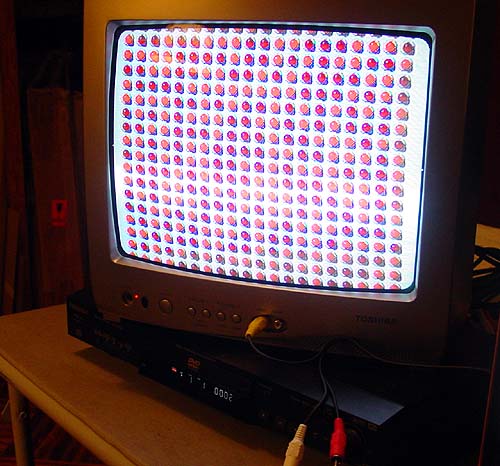
Non-Internet

Internet
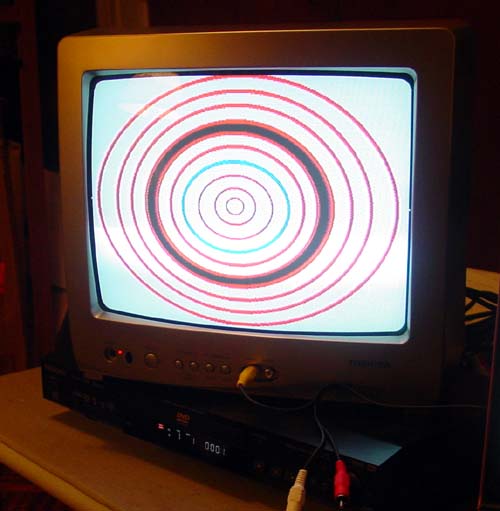
Non-Internet
"I like the ones on the Internet better."
"That's not the point--the shots on the bottom are just documentation of pieces that can never be experienced on the web, just as net art always flops in the gallery setting."
But seriously, I'm pretty happy with the DVDs I just burned (these flared-out shots notwithstanding), inspired by Paul Slocum's work for the Dallas show. Picked up that Toshiba TV on clearance for 74 bucks. The LED Grid is an HTML piece--a found GIF remixed to blink at different rates. I used a capture program to convert it to a video file, then burned the file to DVD, which is then set for chapter repeat in the player. For the OptiDisc piece, the same capture program played the original GIF 12 times to make the video, also set on chapter repeat. I like Paul's idea of burning several animations to one DVD and then having several TVs going at once. Now I know how to do it and don't have to bug my friends so much.
 "Technology cannot exist without the potential for accidents. For example, the invention of the locomotive also entailed the invention of the rail disaster. Virilio sees the Accident as a rather negative growth of social positivism and scientific progress. The growth of technology, namely television, separates us directly from the events of real space and real time. We lose wisdom, lose sight of our immediate horizon and resort to the indirect horizon of our dissimulated environment. From this angle, the Accident can be mentally pictured as a sort of 'fractal meteorite' whose impact is prepared in the propitious darkness, a landscape of events concealing future collisions. Even Aristotle claimed that 'there is no science of the accident,' but Virilio disagrees, pointing to the growing credibility of simulators designed to escape the accident -- an industry born from the unholy marriage of post-WW2 science and the military-industrial complex."
"Technology cannot exist without the potential for accidents. For example, the invention of the locomotive also entailed the invention of the rail disaster. Virilio sees the Accident as a rather negative growth of social positivism and scientific progress. The growth of technology, namely television, separates us directly from the events of real space and real time. We lose wisdom, lose sight of our immediate horizon and resort to the indirect horizon of our dissimulated environment. From this angle, the Accident can be mentally pictured as a sort of 'fractal meteorite' whose impact is prepared in the propitious darkness, a landscape of events concealing future collisions. Even Aristotle claimed that 'there is no science of the accident,' but Virilio disagrees, pointing to the growing credibility of simulators designed to escape the accident -- an industry born from the unholy marriage of post-WW2 science and the military-industrial complex." (hat tip to MBM)

Kathryn Bigelow: A Great "Problematizing" American Movie Director
(Near Dark, Strange Days, K-19: The Widowmaker)
1. Her IMDb bio: "A very talented painter, Kathryn spent two years at the San Francisco Art Institute. At 20, she won a scholarship to the Whitney Museum's Independent Study Program. She was given a studio in a former Offtrack Betting building, literally in a vault, where she made art and waited to be criticized by people like Richard Serra, Robert Rauschenberg and Susan Sontag. She later graduated from Columbia's Film School. She was also a member of the British avant-garde cultural group, Art and Language. Kathryn is the only child of the manager of a paint factory and a librarian."
2. Excellent article on K-19: The Widowmaker. In a nutshell, this is the true story of the maiden voyage of the USSR's first nuclear sub with missile launching capability, in the early 60s. The reactor sprang a leak and the ship almost exploded--World War III narrowly avoided. The captain and crew were heroes for saving the ship but Russia hushed it up till the end of the Cold War.
Excellent movie, beautifully, kinetically filmed, as with all of Bigelow's work. Not a big commercial hit, and how could it be? Aside from the presence of bankable stars Harrison Ford and Liam Neeson (the latter way better than the wooden former), it's contrary to every Hollywood formula and enfatuation. All male cast--no submariners' wives back home, crying and clutching hankies. Female director, like, there's about two of those, and as the article above discusses, this was entirely Bigelow's project. She went to Russia, did the research. Doomed ship: People die horrible, pointless deaths because of bureaucratic stupidity. Russian subject matter: the US Navy lent very little assistance, like they do for Top Gun and all that crap, because it wasn't about the great American military.
We've seen a lot of K-19's moves in Das Boot--the "other side of the war," men on boat undermined by civilian leadership back home. The latter very relevant now with our troops getting chewed up in Iraq because of bad leadership by Rumsfeld, Wolfowitz, and Feith. What's unique and very Soviet is the nuclear theme, with its resonance to Chernobyl--the possibility of death and disfiguration from unseen radiation, caused by the negligence of your own side, is much creepier than just running around evading Allied depth charges.
I read somewhere that women, in polls, say they hate movies like Crimson Tide where two men butt heads to see who has the greater authority. Denzel Washington and Gene Hackman basically bicker throughout that entire dreadful film. "Mutiny" is a subplot of K-19, too, but it plays out in a less expected, more anticlimactic way.
When I first saw the work of painter Kara Hammond, she was drawing Precisionist style graphite drawings of old Russian satellites and spaceships. The "other" of Soviet tech piques a fascination of American artists who are forcefed images of our own wonderful gear. K-19 is a (cinematically centripetal, ever-changing) museum of old Russian tech. See paragraph one about Bigelow's background. More needs to be written about the artistic subversives running silent and deep within the Hollywood system.
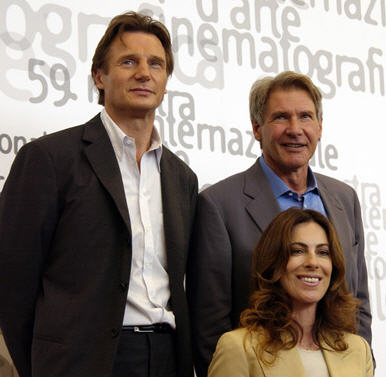
Image from IMDb. One quibble, and another big reason for the film's lack of box office buzz: the title. "K-19: The Widowmaker" sounds like a combo of some scientifically formulated dog food and a lethal bar drink.
More.
Unicorn Hard-on. "Candy's Song" and "Sugar Mountain"--Throbbing Gristle for Candy Stripers? No-budget Chris and Cosey? Words are elusive. Agonizing over some clipping and distortion a few posts back now seems pointlessly fussy. Thanks, again, Travis.

In August 2003, six months after the US invaded Iraq, I visited Texas and was telling a relative there that I had marched a couple of times in hopes of stopping the war. He gave me a slightly pained, "my crazy east coast kin" look, sighed, and said, "I just have to believe the government has access to information we don't have, and they wouldn't have done it if wasn't the right thing." And he's not even a Republican. Well, D___, this is for you. I was right and you were wrong, and I hope next time I see you you'll admit it.
Powell's Former Chief of Staff Lawrence Wilkerson Calls Pre-War Intelligence a 'Hoax on the American People' Tonight on PBS Program 'NOW'*startling if you've been living in a box since 1999.
NEW YORK, Feb. 3 /PRNewswire/ -- In an interview airing tonight on the PBS weekly newsmagazine NOW, Colin Powell's former Chief of Staff Lawrence Wilkerson makes the startling* claim that much of Powell's landmark speech to the United Nations laying out the Bush Administration's case for the Iraq war was false.
"I participated in a hoax on the American people, the international community, and the United Nations Security Council," says Wilkerson, who helped prepare the address.
The NOW report, which airs days before the third anniversary of Powell's speech, examines the serious doubts that existed about the key evidence being used by the American government at the very time Powell's speech was being planned and delivered.
"I recall vividly the Secretary of State walking into my office," Wilkerson tells NOW. "He said: 'I wonder what will happen if we put half a million troops on the ground in Iraq and comb the country from one end to the other and don't find a single weapon of mass destruction?'" In fact, no weapons of mass destruction were found in Iraq.
Bill Hicks on fundamentalist Christians:
"But get this. I actually asked one of these guys: Okay – dinosaur fossils. How does that fit into your scheme of life? Let me sit down and strap in. He says: 'Dinosaur fossils? God put those here to test our faith.' Thank God I'm strapped in right now here, man. I think God put you here to test my faith, dude. You believe that? 'Uh-huh.' Does that trouble anyone here? The idea that God might be ... fucking with our heads? I have trouble sleeping with that knowledge. Some prankster God running around: 'Ho ho ho. [imitates burying fossils] We will see who believes in me now, ha ha ha. I am God, I am a prankster. I am killing Me, ho ho ho.' You know, you die and go to St. Peter: 'Did you believe in dinosaurs?' 'Well, yeah. There were fossils everywhere. [sound of trapdoor opening] Aaah!' 'You fucking idiot! Flying lizards? You're a moron. God was fucking with you!' 'It seemed so plausible! Aaah!' 'Enjoy the lake of fire, fucker!'"

Ad from the Moonie paper, the Washington Times (online edition). They had to hire this T-shirt model because the Cheeto-eating guy with the laptop sitting in his underpants in his Mom's basement wasn't quite "there" in terms of selling the product.
Mailbox
"I went to your show last Saturday at and/or [gallery in Dallas]. A very humble space.
Your work looked good, I want to see those animations on BIG
plasma flat screens hanging on the wall... acting like pseudo-paintings.
Was kinda hoping some of your molecular boxes might make the trip too."
My reply:
Humble is the new bombastic.
Actually, I'm very open to working big: If you want to buy the plasma screens and a G-5 and some high-end software to enlarge the animations, I'm into it.
Otherwise I'll keep working on a scale that doesn't make me feel like a pawn of the system.
Thanks for seeing the show. Oh, and they have a couple of product boxes
Best, Tom

Another detail from an Erika Somogyi drawing. Her show at Monya Rowe is up through Feb. 11. My previous post on the show is here.
Earth Splits Open, Spews Huge Jet of Magma into Space
Artforum Changes Small Black and White Images in Back-of-Mag Review Section to Color
But, seriously, let's talk about the reason for those little black and white photos. It was not because of some written-in-stone policy of general pretentiousness on the part of the journal (and I had a funny conversation with someone the other day who thought ex-editor Jack Bankowsky was a promoter of turgid writing, prompting me to explain that he was actually for English sentences after the impenetrable jargon excesses of the magazine's '70s and '80s).
No, the tiny image policy was meant as a gesture of respect to the artist and testament of belief in the power of the writer.
We have a tendency to see a photo reproduction and say, "Yeah, I saw that show." The bigger and more colorful the photo the more certain we think we are.
So, by making the images postage stamp-like, the magazine was saying, "Stop looking here, you idiot, listen to what the writer is telling you. And if that sounds interesting, go see the actual work next time."
I'm sure the pressure has been enormous on the part of the collectors to see color pictures of the work they're buying, made by their children.
Also, testaments to the power of the writer are no longer in vogue when increasingly the magazine asks museum professionals to do year end Top Tens (it was out of control last December). You know, the people who write catalog essays and wall labels reducing every work of art to some vaguely uplifting, socially relevant purpose.
[/rant]
"Sonar Death Ray" [mp3 removed]. Plucky minimal beats, with death ray.
Two videos from art is for the people (Ludwig Schwarz):

Untitled (Zombies), 2005. I can't stop laughing at this but I could never explain it.
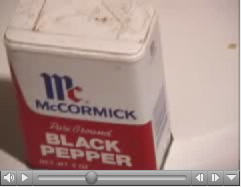
Black Pepper, 2002 (watch it all the way to the end)

John Parker, "Man and Machine" [8.8 MB .mp4]
Originally produced for mutaforma's collective intelligence online project, which involved a lot of remixing of found materials. I like Parker's the best of the videos I saw. His was the only one that seemed to be thinking about the scale of the medium and grabbing the viewer/listener with some kind of strange, immediate emotional experience.
I posted the Parker and Schwarz vids because I like them, and because my Guitar Solo and Drum Machine videos are lonely and wanted a school to hang out with. I've been turning over a vain satirical post about the new Pollocks being artist/musician/video artists who work on a micro-scale.
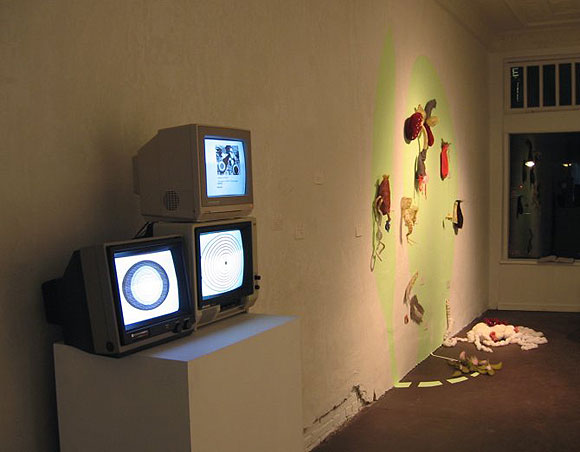

Installation shots from my show with Saskia Jorda (who did the sculpture installation on the right in the top photo) at And/Or Gallery in Dallas. More here. Big ups to Paul Slocum and Lauren Gray for the installation, which included Paul's DVD bootlegs of my animated GIFs, shown very effectively on the TVs, I was told by eyewitnesses.
